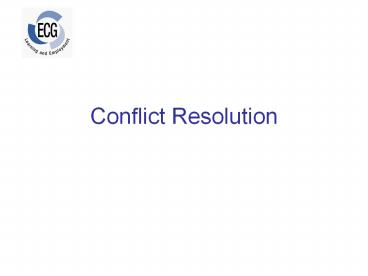Conflict Resolution - PowerPoint PPT Presentation
Title:
Conflict Resolution
Description:
How to work your way through to solving conflict – PowerPoint PPT presentation
Number of Views:8593
Title: Conflict Resolution
1
Conflict Resolution
2
Scoring
- Score the How do you act in conflicts?
- For personal reflection only!
- Do not feel compelled to reveal you scores.
3
Why are people different?
- Learned behaviour.
- Influenced by our
- Childhood up brining
- Culture
- Experiences
- Different people use different styles.
4
Role of a Manager
- Pro-active
- Recognise the signs of conflict
- Neutral / fair
- Set ground rules
- - Both parties to be heard.
- Stick to issue at hand.
- Facilitate an agreed solution
- Support and evaluate
5
Conflict Styles
- The Turtle - Withdrawing
- The Shark Forcing
- The Teddy bear Smoothing
- The Fox Compromising
- The Owl Confronting
6
The Turtle. - Withdrawing
- Withdraws into their own shell.
- Stays away from issues.
- Stays away from people they are in conflict with.
7
The Shark - Forcing
- Overpowers.
- Forces other to accept their solution.
- Seeks to achieve their goal at all cost.
- Not concerned with the needs of others.
- Sees conflict as win or lose.
8
The Teddy Bear - Smoothing
- Want to be accepted and liked by all.
- Avoid conflict.
- Favour harmony.
- Thinks conflict will destroy relationships.
- Like to smooth things over.
9
The Fox - Compromising
- Aims for all parties to gain.
- Compromises.
- Win Win.
10
The Owl - Confronting
- Views conflicts as problems to be solved.
- Solutions are sought to achieve both parties
goals. - Able to maintain a relationship throughout
conflict.
11
Key points to remember
- Privacy
- Your goal, is not always the only or optimal out
come. - Take people concerns seriously, even if they
appear small to you. - If people feel heard and understood its easier to
work through problem - Keep good relationships.
- Dont assume other person knows there is a issue
- Face to face better then emails, phone etc
12
Five styles of conflict management.
High A S S E R T I O N
Low
CO-OPERATION High
13
Signs of Conflict
- Heated exchange
- An increase in turnover rates
- Gossip and rumors
- Tension
- Increased use of personal/sick leave
- Increase in employee grievances or complaints
- Lack of team cohension
- Low morale and trust
- Reduced productivity
14
De-Personalising
- Understand your biases.
- Be aware of your body language.
- Use I messages.
- Use active listening skills.
15
- 6 Steps of Conflict Resolution
16
Step 1.
- Non threatening space
- Appropriate space for discussion- neutral.
- Mutual agreed appropriate time.
- Mediators/facilitators as appropriate.
17
Mediation
- Third person.
- Independent / impartial.
- Draws attention to the key issues and concerns
not emotions. - Set ground rules.
- Both parties to be heard.
- Stick to issue at hand.
- Helps parties involved to make progress.
- Mediator does not make judgments or determine
outcomes.
18
Step 2
- Seek to understand and be understood
- Define the issue (Chart)
- Who.
- Their needs.
- Their concerns.
19
Step 3
- Unpack history
- List past attempts at resolving the issue
- Why - Why not successful
20
Step 4
- Generate options.
- Brainstorm possible solutions.
- Discuss alternatives in a neutral and objective
way. - Discuss pros and cons of all offered solutions.
21
You
- Open body language
- No physical contact
- Face front on
- Make eye contact
- Sit at same level
22
Step 5
- Build agreement
- Agree on one solution to try.
- Agree to end the conflict.
- Agree as to how each individual will work towards
the solution. - Implement.
23
Step 6
- Evaluate
- Set up a meeting to revisit the issue and the
solution tried. - Self evaluation.
- Revisit issues if required.
- Encourage and support parties.
24
Practice Time
25
Conflict resolution style
High A S S E R T I O N
Competition Use power/coercion Win/lose Legal
enforcement Threats/violence
Collaboration Work it out together. Win/win Mediat
ion
Compromise. Split the difference ½ win/1/2
win Negotiation
Accommodation Submission, Compliance
Avoidance. Leave well alone.
Low
CO-OPERATION
High
26
Conclusion
- Privacy
- Pro-active
- Respect
- Commitment
- Recognise your ability
- Effective communication































